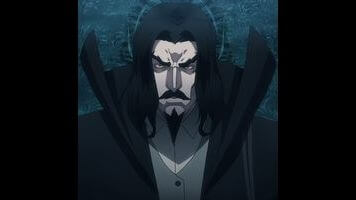Religion is just as dangerous as Dracula in Netflix’s promising Castlevania

Of all the video games you could choose to adapt for TV or film, Castlevania is one of the wiser picks. The story of this influential 30-year-old game series is told in broad strokes, more of a vague framework for the unending struggle between Dracula and humanity than any sort of detailed narrative with complex characters. Dracula is born, Dracula is slain, Dracula is reborn, and so it goes for centuries. It’s about as elemental as it gets, an empty canvas for outside creators to fill with their own vision of its bloody, timeless combination of Bram Stoker, Universal monsters, and anime action.
But dig deep enough, as the creators of Netflix’s new Castlevania animated series have done, and you can find the pieces to build a more multidimensional tale, one that doesn’t presuppose Dracula is some unstoppable force of pure evil who goes around slaughtering humans just for the fun of it. The show’s writers smartly latched onto one of the games’ most simple yet pathos-rich threads: the story of Castlevania III and the tragedy that turned Vlad Dracula Tepes into the leader of a genocidal hellbeast army.
We see more of Drac in the show’s series premiere than we do in any one classic Castlevania game. A human woman, Lisa, visits the spindly, Escheresque castle where he lives as a recluse who likes to impale people on spikes occasionally. (Probably just the ones who show up at his front door looking to kill him.) She’s a healer who hopes to learn from the advanced scientific knowledge he’s accrued across his centuries of life, and within seconds of her arrival, the real conflict of the show’s first season comes in loud and clear. In Warren Ellis’ Castlevania, religion and blind belief are just as dangerous as any vampire.
The country of Wallachia is under the influence of an unnamed, Catholic-like church, and it’s this organization’s own zealotry that brings Dracula’s righteous fury upon humanity. He and Lisa had married, but after she returns to her village and begins using his arcane techniques to practice medicine, the local church leaders declare her a witch and burn her alive. With her dying breaths, she calls out to her husband and begs him to “be better than them,” but the murder of his wife is the last straw. He appears to the townspeople and the incredulous bishop who led the burning, and pledges to loose an army of darkness upon them in one year’s time unless they flee the country and scrub it of their stench. When the day comes and the church has done nothing, Dracula holds to his word, and his demons start tearing people apart.
As promised by the show’s creators, the violence in this scene really is gruesome, almost gratuitously so. If it has a purpose beyond shock value and trying really hard to look cool, it’s to temper our empathy for Dracula. It’s hard to feel bad for the guy when he’s just out here taking revenge for the murder of his wife by a manipulative, power-hungry institution that’s been using his existence to justify its persecution of “heretics,” but it works in the moment, as the camera lingers on a disemboweled torso flying through the air and a child’s severed head lying on the ground.
Then again, even after Dracula disappears and the next three episodes refocus the series on its actual protagonist, the demon-slaying wiseass Trevor Belmont, the church remains the most villainous presence in Castlevania. To the show’s credit, this doesn’t come off as a hackneyed swipe at the notion of faith. People’s belief in the unseen leads to both calamity and triumph throughout. Extremism, avarice, and discrimination are more the evils that plague this church. Its bug-eyed, maniacal leaders lie to their parishioners, label non-believers as “tainted,” threaten violence against them, and use them as scapegoats for Dracula’s attacks.
Trevor himself is the last living member of the Belmont family of monster-hunters, a clan that, despite defending humanity, has been ex-communicated and ostracized because of its dabbling in magic. That backstory sets up Trevor and Dracula as interesting foils, two men who’ve long been spurned by the same powerful organization and its campaign to control the masses through fear. Of course, Dracula’s method of dealing with the issue is to wipe out every inch of humanity, while Trevor resigns himself to defending it, even if he’d rather be left alone to drink and make snarky comments in the dark corner of a pub.
With this first painfully short season lasting only four episodes, Trevor’s march toward Castlevania itself (yes, that’s also the name of Dracula’s castle) has been relegated to the next season, which Netflix has already greenlit and placed at eight episodes. Even though this first batch feels more like a 100-minute prologue than any sort of full self-contained story—laying out the motivations and personalities of the show’s key characters and bringing Trevor together with the two allies he’ll likely be assaulting the castle alongside—its most entertaining scene, in which a particularly nasty demon confronts the holy man who led Lisa’s execution, provides some serious catharsis and a thematically satisfying ending to the church’s brief run as antagonist.
With barely enough material for a feature-length film, it’s difficult to tell how the show will shape up as it moves onto the more traditional, action-oriented parts of Castlevania in season two. But while the animation and writing in this first “season” occasionally stumble along the way, the series’ creators have gone above and beyond to wring a resonant story from a game that never really had or needed one. It’s a promising start, and while this isn’t saying much, that alone makes it one of the most successful video game adaptations to date.